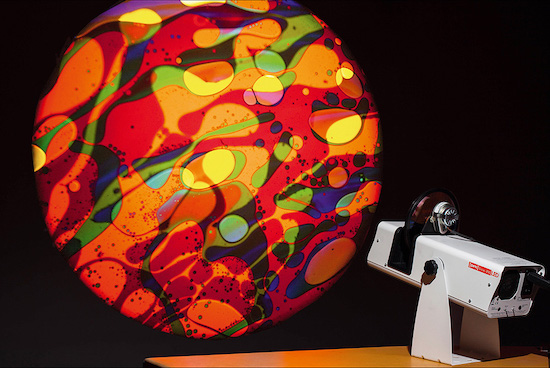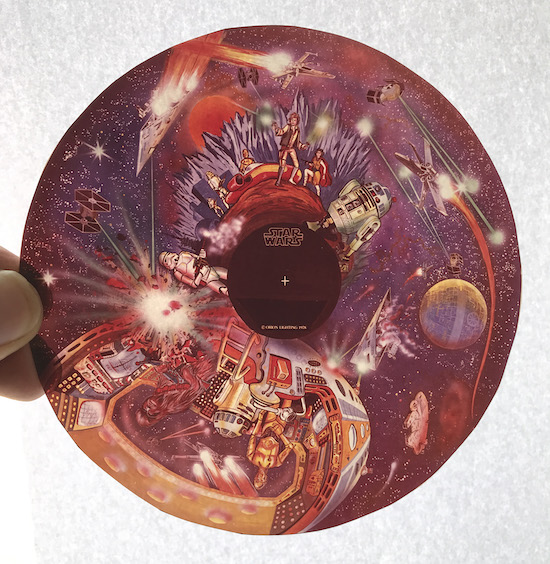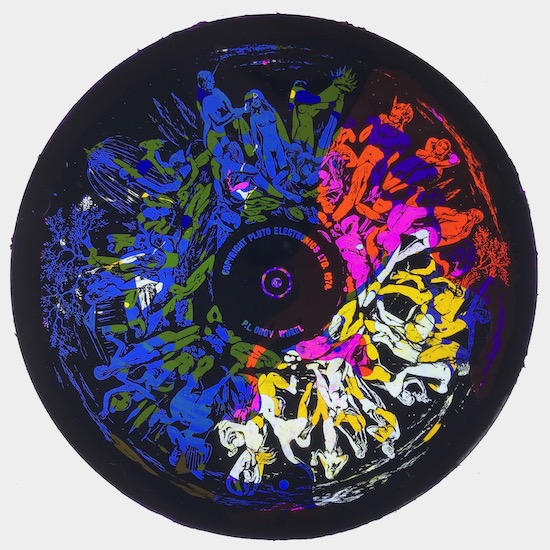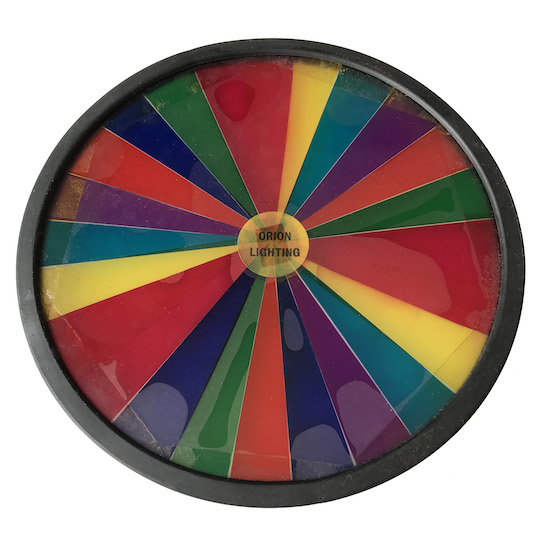Kevin Foakes has many strings to his bow. He’s a DJ and musician, a long time Ninja Tune/ DJ Food/ Solid Steel mainstay, he owns two of the eight mixing hands responsible for one of this site’s favourite LPs (Coldcut’s Seventy Minutes Of Madness), he’s a collector and a graphic designer. And sometimes, all of these interests seem to coalesce into one project, as with The New Obsolescents, the immersive analogue synths, decks and tape manipulation project he helmed with Howlround. Via the project Foakes realised a long standing dream to release a series of highly fetishizable and beautiful looking albums packaged in Héliophore patterned silver foil covers, after finding the last surviving stocks of specialist metallic card from the now defunct Dufex company. These Castle In The Sky releases are now becoming as sought after as the Philips 21st Century Prospective French musique concrète LPs from which they take their design cues.
His latest project, in literal terms at least, speaks to an interest in a very different world entirely, that of psychedelic rock, Fluxus performance art, countercultural happenings, squat parties, crustie rave chill-out tents and prog freak-outs. His new book Wheels Of Light – while on the surprisingly small side – offers a sumptuous visual history of the effects wheel-driven light show.
Under the banner of Further, an immersive, ‘analogue’, AV project he runs with fellow DJ Pete Williams, Foakes began to amass information on effects wheels and projectors, especially from the Optikinetics company. Optikinetics is the last remaining company from what was once a thriving DIY lighting industry of the 1960s and 1970s which supplied art galleries, nightclubs, bars, pubs and gig venues as well as fans of psychedelic home entertainment. As he met key figures from the industry and built up a library of brochures, photographs, interviews and physical effect wheels, he realised he was working on a book.
The book traces the colourful path these odd lighting artefacts blazed, out of the radical arts spaces of the late 60s, into the psychedelic happenings of bands like Soft Machine and Pink Floyd, and out on tour with Jimi Hendrix, then becoming almost mainstream for a short time, before disco’s mirrorballs and flashing lights pushed them back underground.
Those who remember Strictly Kev as one of the key faces at Ninja Tune might be surprised to learn of his interest in these now, pretty much, antiquated lighting effects, especially given that he came up in the club age of VJs and lasers: “My earliest gigs were mainly hip hop shows in the 80s and there’d be little more than a painted banner backdrop with the name of the band on it and some flashing lights if you were lucky. Club gigs were the same, usually neon-lit banners that glowed in the dark, swivelling spin spot lights, smoke and the odd strobe. Come the 90s and things started to get a bit more interesting.

“When I first met Matt Black (from Coldcut) I was aware of the term ‘VJ’ and also that he’d been working in the field through things I’d read in the media or seen on TV. I booked him to VJ at a party called Telepathic Fish that friends and I were putting on in a Brixton squat so he came down with a little video mixer, a couple of VHS players and other bits and pieces I didn’t understand at the time. It was only later that he told me that this was the first time he’d actually VJ’d out in public – this was summer 1993 – up until then he’d been messing around with this stuff in the studio only.”
Do you see things like VJing as standing on a continuum that goes back to the light shows of the 1960s and 1970s?
Kev Foakes: I see it as a continuation of the light show, in as much as the need for a show that interprets and enhances the music being played (either by a band or DJ) is an essential part of a decent live experience, but I see what a VJ – as we know it – does as slightly different. If you want to split hairs, it could be seen as analogue vs digital. Personally, when I hear the term ‘VJ’ I think of digital video systems coming onto the scene in much the same way that affordable samplers did and, rather than having to book expensive studios or edit suites, people were able to mess about with this stuff at home. When I saw what Matt and Hex were doing in the early days it was primitive computer animations played back and effected via video projectors rather than slides, oils and 8mm film via analogue sources. That to me was a whole new thing, the difference between what I’d term a VJ and a light jockey – someone dealing with pure light sources over digital.
How did you get into this more antiquated form of light show; and what was the attraction to you, over a more digital solution?
KF: I’ve always been fascinated with the psychedelic era of the late 60s and 70s, both musically and visually, but most of all I’m always drawn back to the analogue nature of these practices. What we can do at the push of a button with digital technology is astounding now (see any number of AI artists out there today) but the craft of some of the psychedelic pioneers always brings me back. That thing about working within limits breeding invention and innovation and the physicality of it. There’s also that love of seeing ‘an original’ artefact that’s always appealed and finding a huge cache of original wheel art at the Opti HQ was the catalyst for the book. With a digital creation this is the thing that is missing, in the same way that an mp3 is never as aesthetically appealing as a record. The quality of analogue light is different too, it glows like a stained glass window rather than an LED screen.

For those who don’t know, what are effect wheels?
KF: There are three main different kinds; a liquid wheel, an effect wheel and an effect cassette (not to be confused with an audio or video cassette). The first two are generally 6” circular glass or perspex discs sealed with a rubber ring around the outer edge and a metal ‘boss’ in the centre which is where it’s attached to a rotating motor that then slots into a projector. The liquid wheels are, of course, filled with different coloured liquids. Effect wheels (or sometimes picture or panoramic wheels) have an image or pattern either screen printed onto the glass or sandwiched between it in the case of the panoramic wheels. Artists of the day painted panoramic scenes that would wrap round the wheels with the ground at the centre and the sky at the outside. Abstract patterns that could be projected through prism or kaleidoscope lenses were also common. Effects cassettes are smaller 3” circular contraptions that look a bit like a fat camera lens cap. These have op-art-like designs screen printed onto two glass discs inside, one fixed, one that turns on ball bearings, which creates an undulating moiré effect when rotated.
How do they work?
KF: It’s a bit like a larger, motorised version of a Viewmaster with an internal light source. Each wheel is fixed onto a rotator which is a slow-turning motor attached to a metal plate that slots into the ‘gate’ of a projector – an open section between the bulb and the lens. As a section of the wheel rotates past the bulb the image is projected and, depending on the size of the lens you have and your distance from the wall, blown up to a huge size to cover any surface. White or light walls are recommended of course but multiple projectors add to each other to increase brightness. The liquids inside the liquid wheels move and intermingle as the wheel is rotated and the projector bulb heats up. When thrown across a room they look like you’ve got an amoeba’s eye view of some living, colourful molecular landscape, very calming and trippy. As the images on effect wheels revolve you see a never ending scene of whatever the subject matter is – sci-fi, horror or fantasy were popular – eventually looping back to the beginning. Some companies like Pluto Electronics combined the two to form picture liquid wheels too. The effect cassettes would give an animated Bridget Riley-esque op art effect, sometimes in black and white, sometimes in colour, but always rotating from the centre of the image like a vortex.

I think when a lot of us picture The Exploding Plastic Inevitable or UFO club we think about overlapping multicoloured fields which appear to be melting into one another. How is that effect created?
KF: All good light shows are a combination of multiple different kinds of effects, a visual collage rather than one thing aimed at a screen. Rotating mirrors or prisms can throw an image around a room or shatter it into many duplicates. Colour Flash wheels were often employed with slide projectors – rotating acetates in multiple colours arranged around a wheel that spun in front of a projector at a high speed – so that images were red one second, green the next, knocking out the corresponding colours in the slides being shown. Liquids, or ‘wet shows’ as they were sometimes called in the States, were the result of putting combinations of inks, water and oils between glass clock faces and manipulating them over an overhead projector, the same kind a teacher would use to draw on in the classroom and project the results onto the wall. All these sound quite primitive but they were made by customising and adapting the technology of the day and soon those effects were copied in film, later being approximated as digital effects as technology caught up.
These psychedelic light shows started off in the avant garde or in performance art; how did they become part of the countercultural rock scene?
One of the best anecdotes on the UK scene is from Mark Boyle who performed with his wife Joan Hills under names like Mark Boyle’s Sensual Laboratory, firstly at home for friends and later in art galleries and arts labs. He’d been booked to do one of his performances at the UFO club by John ‘Hoppy’ Hopkins, there would be bands, films, classical music and other avant garde goings on, not just rock bands all night. Mark and Joan were one of the first people to experiment with liquids, using all sorts of things they found in their kitchen, sometimes even live insects too. They played before the Soft Machine and Hoppy loved it so much that he asked them to stay on and do the same thing over the band, paying them a tenner to do so. They ended up repeating this all over London, touring with the band and eventually did a US tour with Hendrix before bowing out to concentrate on their art.

The ‘golden age’ of the light show ends in the late 70s, early 80s. What did for it?
KF: A few things. Musical changes and fashions saw them relegated in some quarters, technology caught up with and in some cases superseded them. Disco for instance was more about glitter balls, automated pin spot lights and illuminated dance floors than trippy liquids although the effect cassettes worked somewhat in that era. Clubs and pubs installed their own equipment, some of it automated, which meant there was less need for light show operators but there was room for the odd picture wheel which ran on its own. The real nail in the coffin for most was the recession in the early 80s which put many of the companies making this gear out of business or forced a change of direction. Only Optikinetics managed to navigate these times and still exist today because they diversified into lightweight, temporary scaffolding for exhibitions and stages.
I first remember seeing a full light show at an Ozric Tentacles gig in 1992. Who were the people who kept the spirit alive, as it were.
KF: Once rave happened, promoters wanted the psychedelic lighting again and elements of the techniques fitted nicely into the clubs and raves with people like the Club Dog crew and their Hassid Casualty Light Show being one operating from the mid 80s. Also there was a mini psychedelic revival in the 80s with bands like Doctor & The Medics’ Alice In Wonderland nights, The Crypt club and Bam Caruso’s reissues and associated activities which kept it alive. Zeeman Zap did the lights at Whirl-y-Gig for decades, Fruit Salad Lighting were probably who you saw supporting the Ozrics, they also lit Eat Static and could handle the bigger gigs like Megadog, Glastonbury and WOMAD stages.


